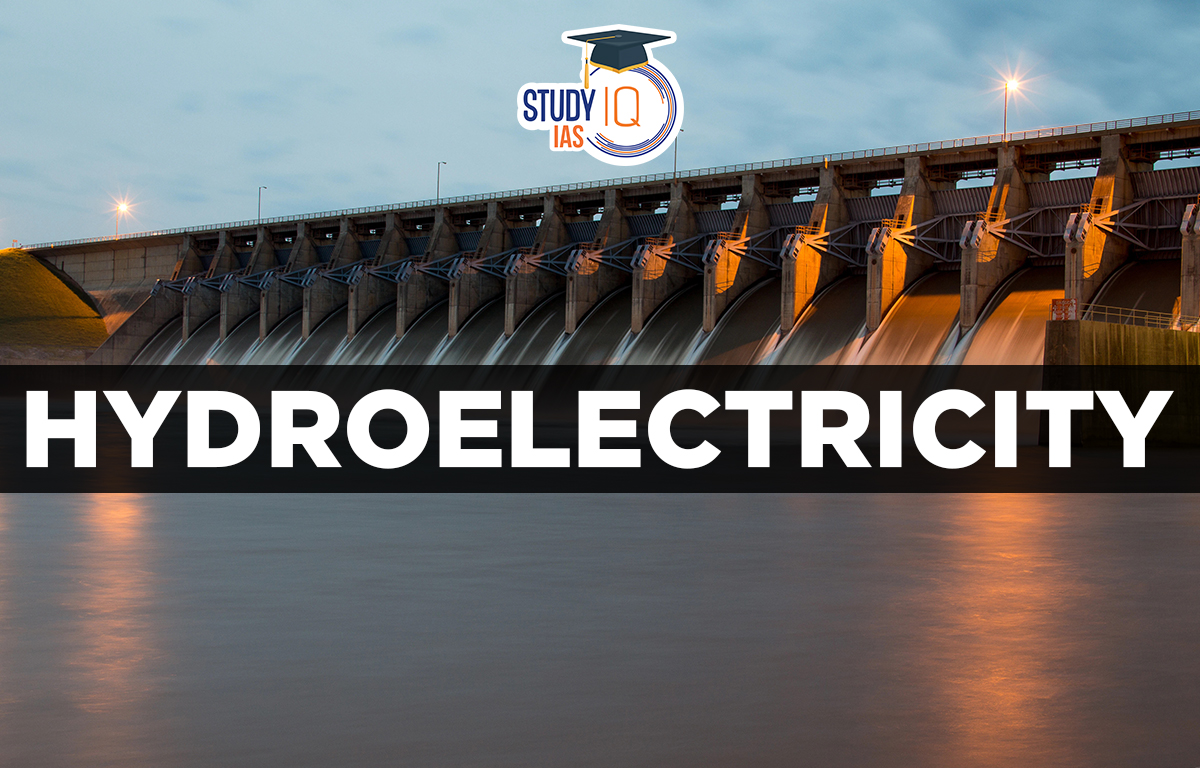Table of Contents
Hydroelectricity
Hydroelectricity refers to the electricity derived from the energy of moving water. It is a renewable source of energy. Most hydroelectric power plants have a water storage area called a reservoir with a gate or valve to control how much water flows out. When water spills over a dam or flows down a hill it has potential energy. As it moves downhill this energy turns into kinetic energy. The flowing water spins the blades of a turbine which generates electricity. This electricity is then sent out to customers.
This type of energy is clean and does not cause air pollution. Hydroelectric power plants can be big, like large dams, or small, like setups that use river flow. The power plant where Hydroelectricity is produced is known as a hydroelectric power plant or hydropower plant. In order to produce hydroelectricity dams are constructed on rivers.
China produces the most hydroelectric power in the world. Other big producers include the United States, Brazil, Canada, India, and Russia. About 71 percent of all renewable electricity made on Earth comes from hydropower.
Read about: Nuclear Power Plants in India
Hydropower Plants Various Forms
Hydropower facilities come in three different varieties: impoundments, diversion, and pumped storage. Hydropower plants vary in their utilisation of dams.
Impoundment Hydropower Plant
There are three types of hydroelectric power plants. The most common type is called an impoundment facility. In this type, a dam holds back water in a pool or reservoir. When more energy is needed, water is released from the dam. Gravity makes the water flow down through a turbine, which spins and generates electricity.
Diversion Hydropower Plant
Another type is a diversion facility. This plant does not use a dam instead, it channels river water through canals to reach the turbines that create power.
Pumped Storage Hydropower Plant
The third type is called a pumped-storage facility. This plant stores energy from sources like solar and wind by pumping water uphill to a higher reservoir. When electricity is needed, the water flows back down to a lower pool, turning a turbine to generate more electricity.
Hydroelectricity in India
Over 53% of India’s electricity was generated using hydropower in 1947, which accounted for about 37% of the country’s overall power-generating capability. The fall in hydropower’s share of capacity and generation began in the late 1960s as coal-based power generation increased. 46,512 MW (megawatts) of hydropower capacity, or around 11.7 per cent of total capacity, was available in 2022. In 2020–21, hydropower generated around 12% of all electricity. There are 197 Hydropower plants in India.
Hydropower Sites Global Distribution
The United States of America and Canada are the world’s top hydroelectric power producers.
| Region | Details |
| North America | The Appalachian Fall line, the Great Lake Falls-St. Lawrence canal, Niagara Falls and St. Anthony in Minneapolis, the Rocky Mountains, and the Laurentian shield are all notable natural hydel power sites. |
| Europe | Italy, France, Norway, Sweden, Germany, and Switzerland produce the majority of Europe’s hydroelectric electricity. |
| Asia | Japan, India, Shanghai and Guangzhou in China, and Cameron Highlands in Malaysia. |
| South America | Brazil is the top generator. Paulo-Alfonso facility, located on the San Francisco River is an important hydropower plant. |
| Africa | Aswan Dam in Egypt, Akosombo Dam in Ghana, and Sennar Dam in Sudan. |
Largest hydroelectric power plant in the world
The Three Gorges Dam in China is the largest dam in the world for making electricity. It stops the Yangtze River and is 2335 meters long and 185 meters (607 feet) tall. The dam has many generators that can produce 22500 megawatts of power.
Hydroelectricity Benefits
- Hydroelectricity uses water to generate electricity without consuming it.
- Hydropower is a renewable energy source that saves water for other uses.
- It is less expensive than electricity from coal and gas-fired power plants.
- It is more dependable because it does not require fossil fuels and avoids financial losses from frequency changes.
- Hydropower stations can start and stop quickly, making them ideal for handling peak loads in grids.
- Hydroelectric and thermal power plants complement each other, promoting efficient resource use.
- The seasonal load curves of regional grids match the pattern of hydropower generation.
- During summer and monsoon seasons, hydroelectric plants produce more electricity due to high agricultural workload.
- In winter, thermal stations operate at base load, while hydro stations handle peak loads.
Hydroelectricity Limitations
- Hydropower potential in central India (Godavari, Mahanadi, Nagavali, Vamsadhara, and Narmada rivers) hasn’t been fully explored due to opposition from tribal people.
- Hydropower’s share in electricity production has dropped to about 10%, with most electricity (80%) coming from thermal power.
- Many hydropower projects face delays because of long land acquisition and resettlement processes, complex planning, lack of infrastructure like transmission lines, small market size, and long-term financing issues.
- India has many stalled hydropower projects due to environmental lawsuits, local protests, financial problems, and lack of buyers.
Only an extra 10,000 MW of hydropower was added in the last ten years. - Water and water power are state issues, causing conflicts between states and delaying hydropower projects, like the Subansiri project.
Hydroelectricity UPSC
There are 197 Hydropower plants in India. India started to gain power at the end of the 19th century. The Sidrapong Hydropower facility, a hydroelectricity project, was inaugurated in Darjeeling in 1897. And in 1902, a hydroelectric power plant in Karnataka’s Sivasamudram was put into operation. For the UPSC exams, hydroelectricity is an important topic that can be found in General Studies.


 Role of Teachers in Educations, Student ...
Role of Teachers in Educations, Student ...
 India's achievements after 75 years of I...
India's achievements after 75 years of I...
 Bal Gangadhar Tilak Biography, Achieveme...
Bal Gangadhar Tilak Biography, Achieveme...
























